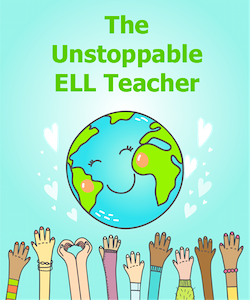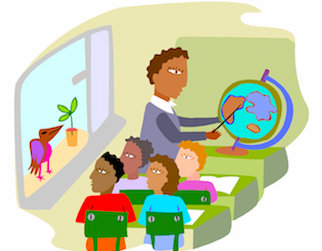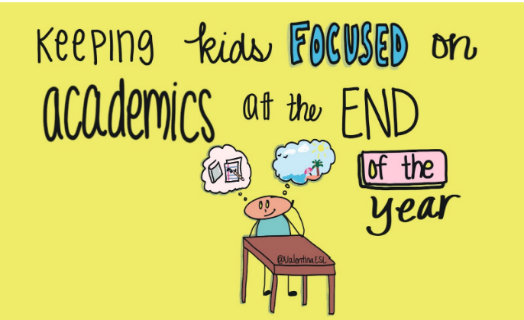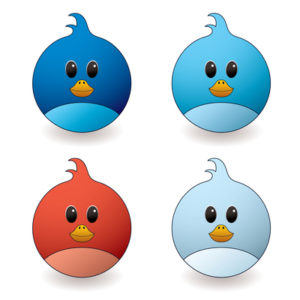Ending the School Year with English Learners
A MiddleWeb Blog

For students, the summer bug hits and all they can think about is vacation, days off, hanging out with friends, sleeping in, and staying up late. Basically visions of sugar plums dance in their heads.
That’s why it’s important that at the end of the year we keep to a routine as much as possible. Educators and students alike benefit from structure. Creating classroom environments that continue routines will help students to focus on learning rather than get distracted by daydreams about summer vacation.
Don’t Fall Victim to the Countdown
Some kids are excited because they have great plans and travel, and others are anxious about school letting out because they will be lonely and might not have anything to do. Either way, every day of school counts. However – “the countdown” until summer seems to hurt that theory.

Countdowns often create an atmosphere of chaos and disorder. Don’t fall victim to the end-of-year countdown!
They tends to send the wrong message. If we want students to stay in the “game” until the end, we should avoid dangling a carrot in front of them that constantly reminds them of vacation. Instead, keep their focus on learning.
Gear UP!
About when we start hearing kids count down until summer vacation, that’s when we should start seriously planning for tighter, more focused lessons.

Debate IT
For example, have students choose a relevant critical issue and research and debate it. You can make a list of topics and let students add to the list through brainstorming. Then let them select a topic with a partner and research. Then partners pick a side and debate the topic.
Blog IT

Get blog site ideas from Gallit Zvi and Denise Krebs in this MiddleWeb post.
Teach students to create their own blog tied to a topic they are passionate about. Share with them how blogs are used to express ideas and affect a wide audience. The autonomy of this type of project will be pleasing to students. When we enjoy what we read and write about, it comes much more naturally (for students and adults alike, right?).
Syllabus
Have students help you develop a syllabus and introduction to your course for next year’s students. Divide the class into groups and give each group a section to work on, such as classwork, homework, late work, work ethic, behavior, etc. Each group is responsible for the content of the section. Students can create on PowerPoint, paper, Word document, Google, or whatever platform you wish to have them share. The power lies in the authentic audience that students are creating for.
Evaluate
I absolutely love the end-of-year ideas that Larry Ferlazzo offers in this article. One includes having students fill out an evaluation regarding his teaching and the class. This gives great feedback to teachers regarding what worked for students and what didn’t. Students can fill out the surveys anonymously in an effort to be more honest in their responses. And you can start fine-tuning over the summer break.
Set them up for Summer
The end of the year is the perfect time to gear students up for summer learning by brainstorming ideas to stay connected. The best part of this is that it won’t even seem like learning to them. During the summer, many students digress in learning. Two to three months off from reading, writing, listening or speaking using academic language is a long time. Students begin to forget what they acquired.

I heard about one teacher who had a class stuffed animal that was passed around weekly during the summer. Students took pictures of it as it went on adventures with them to the library, the museum, the water park, the mall, the grocery store, on a walk, etc. They posted pictures on Instagram with captions.
It was a fun way for the class to stay connected, to socialize and to write and comment on each other’s posts. Some kids even captioned theirs with questions like, “Can you guess where ___ is this sunny afternoon?” And classmates tried to guess the location of the mascot based on the picture.
The last month is also the perfect time to advertise summer reading. By highlighting engaging books that students may connect with, you can tempt them to read over the summer and perhaps organize some book clubs. If you’re careful about it, they will think this is their brilliant idea and love it even more.
End Strong
Just like this little mouse, we have to END the year STRONG. This short video is a commercial for cheese, but it’s also a good reminder that even when we think the end is near, we have to get up and give it our best shot!
The mouse was beat down by the trap (like we may feel by the end of the school year), but instead he used that the trap to build his strength. We can use the end of the year to our advantage too. It’s a good video to share with school-weary kids.
Happy end of the school year to you all!



































I love these ideas. This is the time of year for teachers to use their most creative, fun units and themes.
So true about the countdown! It’s tempting to throw up a count down on the board, but it tends to send the wrong message. I also like giving the idea of getting feedback from your students to help you plan for the next year. Great suggestions!